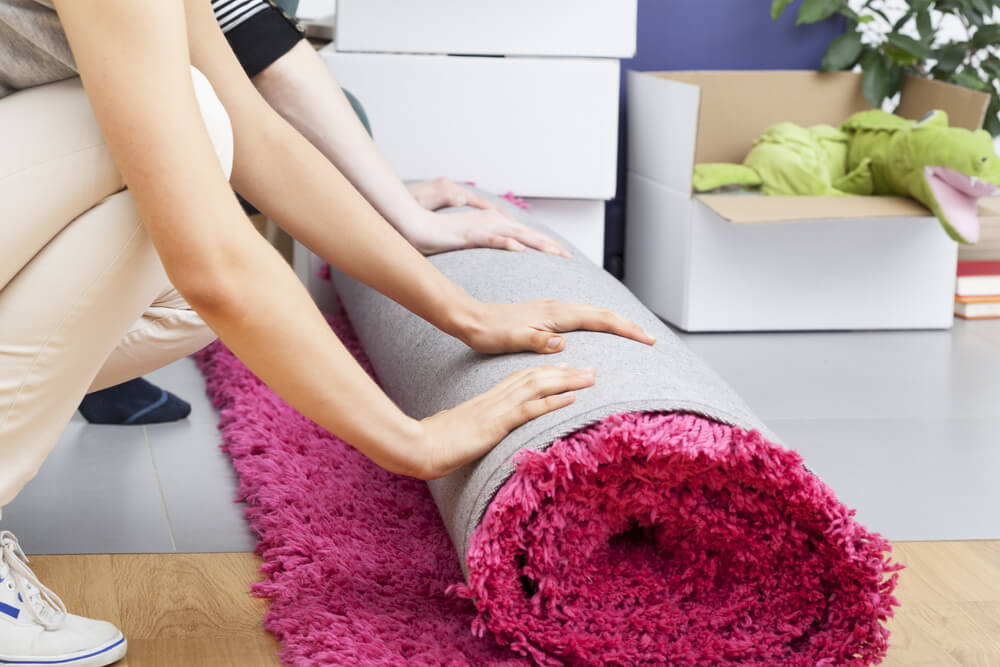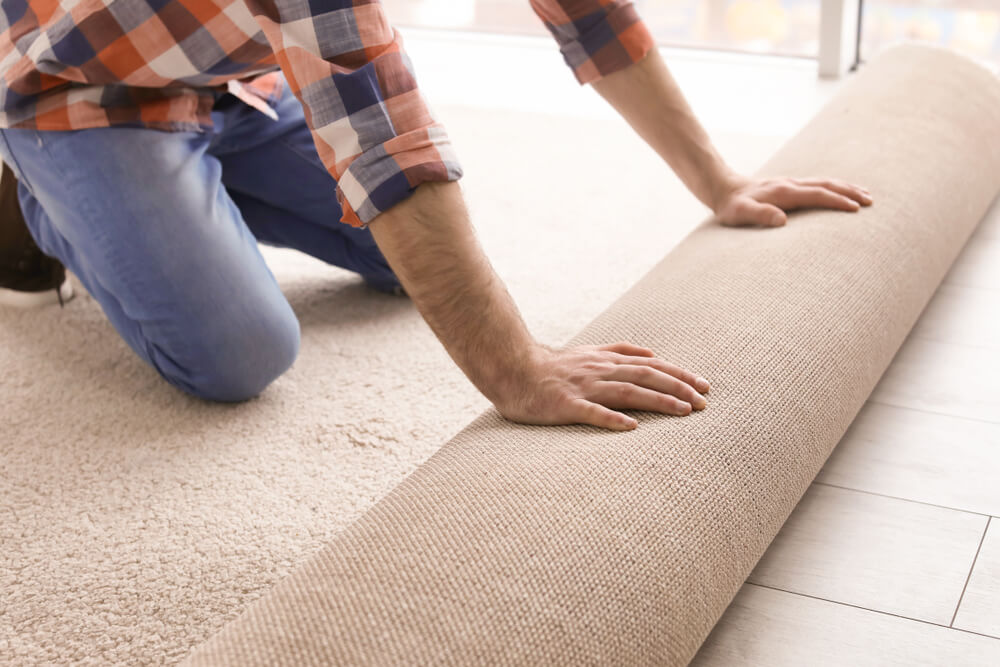Carpet laying may seem like a daunting task, but with the right tools, techniques, and a step-by-step guide, you can achieve close-to-professional results on your own.
Whether you’re looking to replace worn-out carpeting or add a touch of warmth and comfort to your space, learning the ins and outs of a DIY carpet installation is a valuable skill. In this comprehensive guide, we will walk you through the process of laying a carpet, providing you with the knowledge and confidence to tackle this project like a pro.
So, wait no more, and start learning the basics of DIY carpet installation. The full instructions are below!
Or, if you prefer pros to upgrade your space, do it with Triad Flooring and Bath. Contact us now for exceptional flooring solutions and expert installation.
Laying a Carpet: How To?

Installing a carpet requires going through multiple phases of the process. First, we’ll have to finish the planning and preparation part. Then, we can proceed to the hands-on work.
DIY Carpet Installation: Planning and Preparation
Before diving into the carpet installation process, it’s essential to take the time to plan and prepare adequately. Here are the key steps to get started:
Step 1 – Measure the Space
Accurate measurements are crucial when ordering carpets. The colors won’t matter if the carpet can’t fit!
Measure the length and width of the room, accounting for any nooks, alcoves, or irregularities. Then, you can proceed to the next step.
Step 2 – Acquire the Necessary Tools
To ensure a smooth installation, gather the essential tools, including a carpet knife, tack strips, knee-kicker, power stretcher, seam adhesive, carpet cushion, measuring tape, and a stapler.
Being prepared is one of the vital carpeting installation tips to remember.
Step 3 – Choose the Right Carpet
Select a carpet that suits your needs and preferences. Consider factors such as carpet type, pile height, durability, and color to find the perfect fit for your space.
There are plenty of options on the market today, so do your research before making a commitment you’ll regret.
Removing the Old Carpet and Preparing the Subfloor
To install a new carpet, you must first remove the old carpeting and prepare the subfloor. Follow these steps:
- Clear the Room
Don’t let anything get in your way. The area must be cleared so you can have space to start the carpeting installation process. So, remove all furniture, fixtures, and obstacles from the room before starting the removal process.
- Remove the Old Carpet
Starting from a corner, carefully peel back the carpet, cutting it into manageable sections using a carpet knife. Roll up and discard the old carpet.
- Inspect the Subfloor
Thoroughly examine the subfloor for any damage, such as loose boards or uneven surfaces. Repair or replace damaged sections to ensure a level and smooth base for your install the carpet you’ve prepared.
- Clean the Subfloor
Vacuum and clean the subfloor to remove any debris, dust, or adhesive residue. A clean surface promotes better adhesion and ensures a professional finish.
Carpet Laying 101: Carpet Padding
Carpet padding, also known as carpet cushion, provides additional comfort and insulation and prolongs the life of your carpet. Follow these steps to install it correctly:
Step 1 – Unroll the Carpet Padding
Start at one end of the room and unroll the carpet padding perpendicular to the direction you plan to lay the carpet. Trim any excess padding and secure the seams with adhesive tape.
Step 2 – Secure the Padding
Attach the carpet padding to the subfloor using a stapler or adhesive, ensuring it’s taut and smooth. Avoid overlapping or bunching the padding.
Carpet Laying: The Bread and Butter
Now comes the exciting part learning how to lay a carpet! Follow these steps to achieve a professional installation:
- Lay the Carpet Out
Roll out the carpet, allowing it to overlap the walls by a few inches. Align the carpet’s edges with the walls and ensure it’s centered in the room.
- Install Tack Strips
Along the perimeter of the room, install tack strips, leaving a small gap between the strips and the walls. Make sure the pins face the walls to hold the carpet firmly in place.
- Stretch the Carpet
Starting in one corner, use a knee kicker to push the carpet toward the walls, attaching it to the tack strips. Repeat this process on each side of the room.
- Power Stretching
Use a power stretcher for larger rooms to achieve maximum tension and prevent wrinkling or sagging. Attach one end of the power stretcher to the carpet’s edge and the other end against the opposite wall. Activate the power stretcher to pull the carpet tight, then secure it to the tack strips.
- Trimming and Seaming
Trim the excess carpet along the walls, using a carpet knife and a straightedge as a guide.
When joining two carpet pieces, use a seam adhesive and a seam roller to create a seamless and secure bond.
Finishing Touches
Once the carpet is installed, there are a few final steps to complete the project:
- Trim Excess Carpet
Trim any visible excess carpet using a carpet knife, ensuring a clean and professional appearance.
- Install Thresholds and Transitions
Install thresholds or transitions where the carpet meets different flooring types, ensuring a seamless and safe transition.
- Vacuum and Clean
Thoroughly vacuum the newly installed carpet to remove any loose fibers or debris, leaving it fresh and inviting.
Choosing the Right Color of Carpet for Your Space
When it comes to selecting a carpet for your space, the color is a crucial consideration. The right color can transform the look and feel of a room, while the wrong choice can clash with your décor and disrupt the overall aesthetic. Here are a few tips to help you choose the perfect color for your carpet.
First, consider the size of the room. If you have a small space, lighter colors can create an illusion of openness and make the room appear larger. On the other hand, darker colors can add warmth and coziness to larger rooms.
Next, take into account the purpose of the room. For high-traffic areas, such as the living room or hallway, choosing a color that can camouflage dirt and stains, like a mid-tone or patterned carpet, is advisable. In bedrooms or areas where you want a relaxing ambiance, opt for soothing and neutral shades that promote a sense of tranquility.
Also, think about the existing color scheme and furniture in the room. Consider whether you want the carpet to be a focal point or blend seamlessly with the surroundings. If you have bold furniture or vibrant walls, a neutral carpet can balance the overall look. Alternatively, if you have a more subdued palette, you might want to introduce a pop of color with your carpet choice.

What You Learned
By following this comprehensive DIY step-by-step guide, you can learn how to install a carpet like a pro.
Each step contributes to successful carpet installation, from planning and preparation to removing the old carpet, preparing the subfloor, installing the carpet padding, and laying the carpet.
With patience, attention to detail, and the right tools, you can transform your space and enjoy the comfort and beauty of a professionally installed carpet.
Or, for Carpet Sales And Installation in Greensboro, NC, contact Triad Flooring and Bath.


